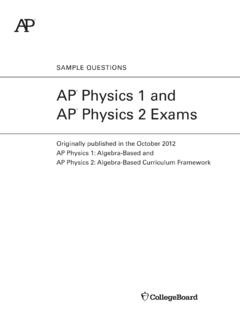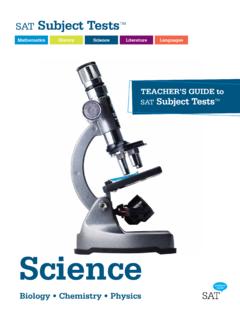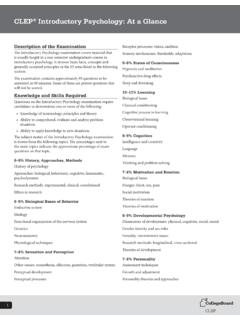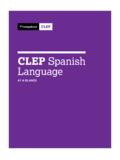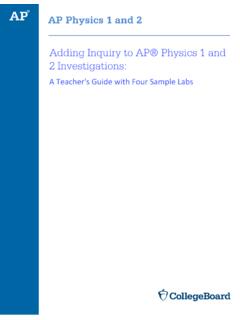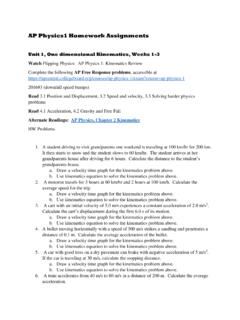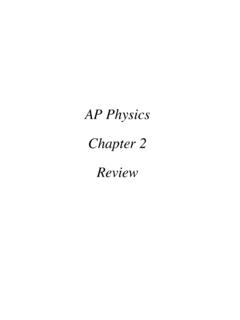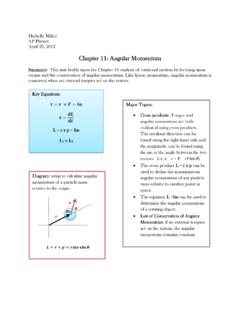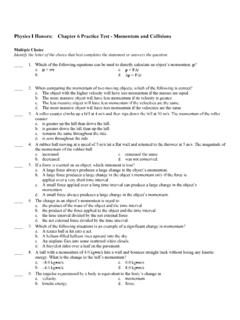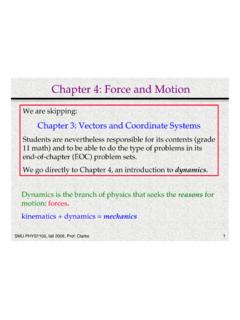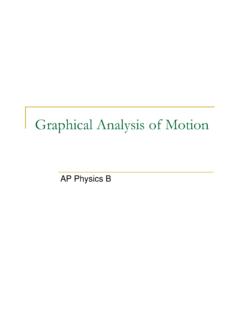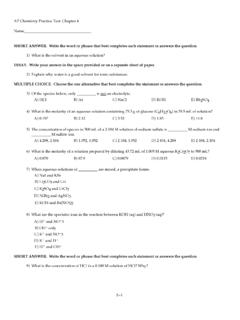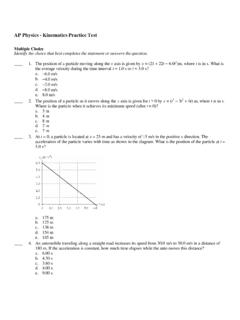Transcription of AP® PHYSICS C: MECHANICS - College Board
1 AP PHYSICS C: MECHANICS About the Advanced Placement Program (AP ) The Advanced Placement Program has enabled millions of students to take College -level courses and earn College credit, advanced placement, or both, while still in high school. AP Exams are given each year in May. Students who earn a qualifying score on an AP Exam are typically eligible to receive College credit and/or placement into advanced courses in College . Every aspect of AP course and exam development is the result of collaboration between AP teachers and College faculty. They work together to develop AP courses and exams, set scoring standards, and score the exams. College faculty review every AP teacher s course syllabus. AP PHYSICS Program The AP Program offers four PHYSICS courses. AP PHYSICS 1 is a full-year course that is the equivalent of a first-semester introduction College course in algebra-based PHYSICS . AP PHYSICS 2 is a full-year course, equivalent to a second-semester introductory College course in PHYSICS .
2 The course covers fluid MECHANICS ; thermodynamics; electricity and magnetism; optics; and quantum, atomics, and nuclear PHYSICS . AP PHYSICS C: MECHANICS is a half-year course equivalent to a semester-long, introductory calculus-based College course. It covers kinematics; Newton s laws of motion; work, energy, and power; systems of particles and linear momentum; circular motion and rotation; and oscillations and gravitation. AP PHYSICS C: Electricity and Magnetism, a half-year course following PHYSICS C: MECHANICS , is equivalent to a semester-long, introductory calculus-based College course and covers electrostatics; conductors, capacitors, and dielectrics; electric circuits; magnetic fields; and electromagnetism. AP PHYSICS C: MECHANICS Course Overview AP PHYSICS C: MECHANICS is equivalent to a one-semester, calculus-based, College -level PHYSICS course, especially appropriate for students planning to specialize or major in physical science or engineering. The course explores topics such as kinematics; Newton s laws of motion; work, energy and power; systems of particles and linear momentum; circular motion and rotation; and oscillations and gravitation.
3 Introductory differential and integral calculus is used throughout the course. LABORATORY REQUIREMENT AP PHYSICS C: MECHANICS should include a hands-on laboratory component comparable to a semester-long introductory College -level PHYSICS laboratory. Students should spend a minimum of 20 percent of instructional time engaged in hands-on laboratory work. Students ask questions, make observations and predictions, design experiments, analyze data, and construct arguments in a collaborative setting, where they direct and monitor their progress. Each student should complete a lab notebook or portfolio of lab reports. PREREQUISITE Students should have taken or be concurrently taking calculus. AP PHYSICS C: MECHANICS Course Content The AP PHYSICS C: MECHANICS course applies both differential and integral calculus and provides instruction in each of the following six content areas: Kinematics Newton s laws of motion Work, energy and power Systems of particles and linear momentum Circular motion and rotation Oscillations and gravitation Learning Objectives for Laboratory and Experimental Situations Students establish lines of evidence and use them to develop and refine testable explanations and predictions of natural phenomena.
4 Focusing on these disciplinary practices and experimental skills enables teachers to use the principles of scientific inquiry to promote a more engaging and rigorous experience for AP PHYSICS C: MECHANICS students. Such practices or skills require students to Design experiments Observe and measure real phenomena Organize, display, and critically analyze data Analyze sources of error and determine uncertainties in measurement Draw inferences from observations and data Communicate results, including suggested ways to improve experiments and proposed questions for further study A minimum of 20 percent of instructional time is devoted to hands-on and inquiry-based laboratory investigations. m (M m) m M (M m) m (M + m) m M m (a) (b) (c) (d) (e) AP PHYSICS C: MECHANICS Exam Structure AP PHYSICS C: MECHANICS EXAM: 1 HOUR, 30 MINUTES Assessment Overview The AP PHYSICS C: MECHANICS Exam includes questions posed in a laboratory or experimental setting.
5 Questions assess understanding of content as well as experimental skills. The exam may also include questions that overlap several major topical areas or questions on miscellaneous topics such as identification of vectors and scalars, vector mathematics, or graphs of functions. Students will be allowed to use a four-function, scientific, or graphing calculator on the entire AP PHYSICS C: MECHANICS and AP PHYSICS C: Electricity and Magnetism Exams. Scientific or graphing calculators (including the approved graphing calculators listed at ) cannot have any unapproved features or capabilities. Format of Assessment Section I: Multiple Choice | 35 Questions | 45 Minutes | 50% of Exam Score Individual Questions Questions in Sets Section II: Free Response | 3 Questions | 45 Minutes | 50% of Exam Score Laboratory Based Discrete Questions AP PHYSICS C : MECHANICS SAMPLE EXAM QUESTIONS Sample Multiple-Choice Question Correct Answer: B Sample Free-Response Question (a) On the figure below, draw and label the forces (not components) acting on the ball at their points of application as it rolls along the roof.
6 (b) Calculate the force due to friction acting on the ball as it rolls along the roof. If you need to draw anything other than what you have shown in part (a) to assist in your solution, use the space below. Do NOT add anything to the figure in part (a). (c) Calculate the linear speed of the center of mass of the ball when it reaches the bottom edge of the roof. (d) A wagon containing a box is at rest on the ground below the roof so that the ball falls a vertical distance of m and lands and sticks in the center of the box. The total mass of the wagon and the box is 12 kg. Calculate the horizontal speed of the wagon immediately after the ball lands in it. Educators: Students: 2016 The College Board . 00558-044 (Updated December 2016)
